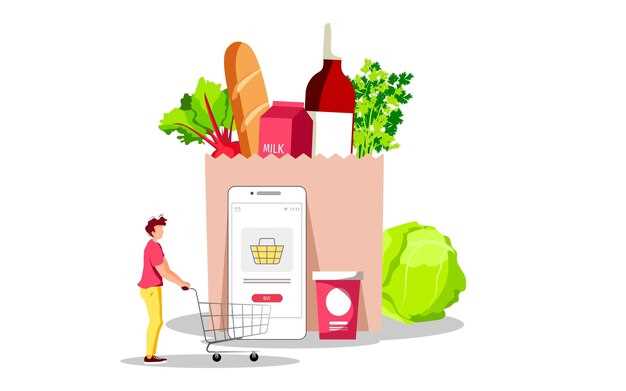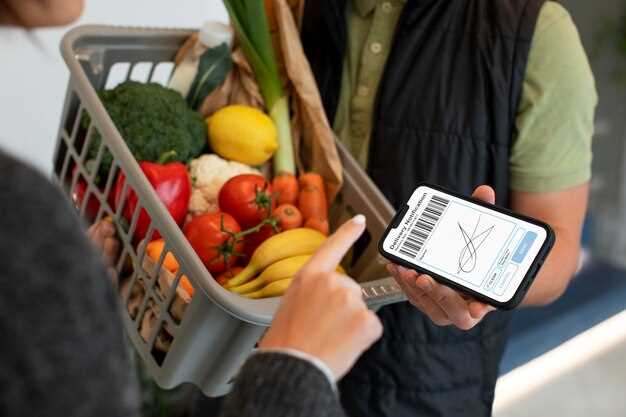Adopt ai-powered last-mile delivery to cut delivery times by 25-35% and keep perishable items fresh, ensuring reliable service from store to door. By focusing on transporting groceries efficiently, you meet needs and turn lengthy waits into a convenient, predictable experience.
That transformation took root when retailers started to test real-time route optimization and precise execution on the road. Real-time route optimization reduces idle miles, while temperature control keeps seafood and other perishable items at safe levels from pickup to doorstep. Track each thing from order to delivery with clear status updates to avoid surprises.
Special capabilities like temperature-monitored containers, smart lockers for returns, and ai-powered dispatch ensure on-time windows. A small fleet can cover 60-90 households per hour when traffic is light, while larger zones require cross-docking and repositioning to maintain αξιόπιστο service. This approach would also boost customer trust and reduce calls about delays.
Start with data-driven steps: map customer needs, segment the day into 3-4 blocks, and aim for a 95% on-time delivery rate. Set a baseline: 10-20% of orders include seafood, and track spoilage by item category to identify high-risk items. Invest in temperature-controlled bags and driver training to keep things cold or cool during peak hours.
Then implement continuous improvement: collect feedback, adjust routing, invest in training, and scale gradually with pilots in two districts. The focus stays on keeping the shopping experience convenient while expanding coverage along major distribution corridors, so customers feel the work of teams delivering on promises.
Practical Framework for Last-Mile Grocery in Food OEM Operations

Adopt a two-tier last-mile model with micro-fulfillment hubs embedded in brick-and-mortar networks near high-density stores to cut road time and enable instant replenishment for high-velocity SKUs, including items used by restaurants.
Structure the flow with OEM orders funneling into a plan hub, then hub-to-store dispatch and direct-to-consumer legs. Use cross-docking to move items from supplier to stores with minimal handling; keep cold chain intact for life-critical items to extend life; implement route optimization and dynamic scheduling to reduce road miles; assign dedicated drivers for high-demand routes to improve operational reliability. Aligning with suppliers and stores ensures forecast accuracy and reduces stockouts. The game is to cut waste and keep stores well stocked; dont rely on guesswork, cannot afford errors.
Operational targets should focus on reducing waste and increasing speed. Most time goes to picking, packing, and hand-offs; automate with pick-to-light and mobile scanners; use real-time visibility to prevent bottlenecks. Keep high-priority items in a fast lane and use instant reorder triggers for top SKUs. Track metrics: on-time to stores, order fill rate, spoilage rate, transit time, and cost per delivery. Use a simple dashboard to alert when SLAs are breached and auto-adjust routes.
Collaborate with the company, OEMs, supermarkets, and restaurants to standardize SKU lists, including standard pack sizes and handling instructions; for life-critical items, use temperature-controlled units and data loggers; share forecast data to prevent overstock and waste. Run pilots in a few markets to validate ROI and adjust fleet mix, including the use of smaller vans for dense urban routes and larger trucks for regional legs. Use used packaging materials where possible to cut waste.
Map Customer Journeys: From Online Order to Doorstep
Assign one owner for each touchpoint in the end-to-end order-to-doorstep flow, and establish a 15-minute daily review to track availability, late delivery risk, and service levels.
From the beginning of the process, align online signals with brick-and-mortar realities: ensure catalogs reflect current stock, price, and freshness in supermarkets, and connect to a live inventory feed that improves availability.
The map focuses on the handoffs: online cart to order, order to warehouse, warehouse to courier, and courier to doorstep, with clear ownership at each point.
Each facility links store shelves to couriers, balancing capacity, resources, and stock levels to meet customer expectations and needed demand.
Implement a simple pilot that uses real-time signals to map points of delay and identify where resources are needed; use this practice to streamline routing across complex networks.
Late deliveries call for a proactive support system: publish ETA windows, send proactive notifications, offer flexible options, and ensure customer support is ready to assist.
Everybody benefits when the data is shared: marketing aligns promises with capacity, operations reduces waste, and executives see clear cost-to-service insights.
Manufacturers and supermarkets can reinforce the map by sharing lead times and replenishment signals, reducing gaps and improving availability at the doorstep.
Maintenance and evolution: review every few weeks, adjust for new partners, update routes, and keep the map easy to read with common terminology so teams across the organization can act.
Forecasting Demand and Managing Fresh Inventory for Last Mile

Use a rolling 14-day forecast by SKU and store to align each order across the fleet, and consolidate multiple store needs into a single weekly replenishment to cut last-minute trips and protect margins. This is a practical step for teams to adopt quickly, keeping planning simple and actionable.
Gather signals from sales, promotions, weather, holidays, and local events. Clustering stores by demand patterns and fresh profiles reveals unique segments you can share forecasts and inventory decisions across both brick-and-mortar and online channels.
Convert forecast into basics: set min and max levels per SKU per store, target 95% of SKUs available for core items, and keep 2-3 days of fresh cover in DCs and stores to reduce wasted stock and protect margins; address last-minute spikes with flexible replenishment, making the process convenient for store teams and customers.
Design the last mile around a compact, flexible fleet that can handle swings in demand. Use faster routing, cross-docking when volume spikes, and near-live updates to reduce mile traveled and redundant trips; this approach helps everybody rely on fresh stock without overburdening the network.
Example: A regional grocer implemented clustering and a shared forecast across 5 store clusters. Within 8 weeks, core item in-stock rose to 98%, waste dropped 18%, and margins improved by 3–4% on fresh categories. The approach proved convenient for customers and made replenishment faster without duplicating orders.
Everybody in the team can read a simple dashboard showing availability, waste, and margin trends; use these signals to adjust step-by-step procedures and keep the focus on availability and freshness across mile-long last-mile operations.
Cold Chain Compliance: Temperature Monitoring, Packaging, and Handling
Adopting a 24/7 temperature monitoring system across cold-storage points directly supports groceries freshness and safety. Install validated probes at loading docks, distribution hubs, and last-mile vehicles, and connect them to automatically triggered alerts that trigger when temps drift outside 2-8°C for refrigerated items or -18°C for frozen goods. Tie monitoring to etas so dispatch can adjust routes in real time. This practice supports growing user trust among shoppers.
Maintain cold-storage zones at 2-8°C and frozen zones at -18°C; use data loggers that record at least every 15 minutes during transit and at loading/unloading checkpoints. A user-friendly dashboard summarizes temps, excursions, and duration, usually accessible to the user on mobile and desktop. Alerts trigger automatically when readings breach the target window, enabling immediate corrective action when needed.
Packaging options including insulated boxes, rigid foam coolers, gel packs, and phase-change materials that maintain target temps for 6-24 hours depending on external conditions. Such packaging is commonly used across multiple groceries deliveries and can be tested with real-world routes to confirm performance.
Define a step-by-step handling protocol from cold-storage to last mile, ensuring goods are transferred directly to refrigerated vehicles, with minimal door openings. Pre-cool items before loading and apply strict chain-of-custody labels at every handoff. This practice reduces risk of temperature excursions and protects product quality. Such practices increase repeatability across routes.
Data-driven management: Record and review at points along the route; volumes of groceries moved per route; analyze excursions to identify points of failure; implement corrective actions. This strategy focuses on reducing excursions and improving response times.
Habits and training: Train users across warehouses, drivers, and store staff; provide practical checklists, including habits such as verifying temperatures before departure and validating packaging integrity; adoption should be measured with quick audits.
In contrast to passive storage, automated monitoring reduces excursions; as volumes grow with last-mile expansion, increased reliability and traceability follow. This contrast helps operations keep groceries within target ranges across routes.
Rollout plan: begin with a three-hub pilot over 6 weeks; scale to full network within 90 days; track spoilage rate, on-time deliveries, etas, and customer satisfaction. This approach would improve consistency, help managers forecast capacity, and sustain adopted practices.
Real-Time Route Optimization for Perishables and Time-Sensitive Goods
Implement ai-powered routing with updates every 2-5 minutes to keep schedules aligned and ensure temperature-monitored conditions are maintained, so that items are delivered on time.
Real-time routing uses live traffic, weather, and order changes to recalculate the next-best path. It prioritizes fast handoffs, minimizes idle time, and factors available drivers, vehicle types, and depot constraints, keeping availability accurate and preserving promised windows for customers.
Reducing backtracking and unnecessary detours lowers costs by 12-25% in typical urban networks, while shaving total drive time by 20-30% and boosting on-time delivery rates to 95% or higher under normal conditions. The system compares multiple routing options, evaluates expected ETAs, and checks temperature constraints to prevent cold-chain violations.
Maintaining product quality relies on temperature-monitored sensors in each container, real-time alerts for deviations, and automatic rerouting when a sensor detects out-of-range conditions. This ai-powered approach prioritizes high-priority items first, preserves cold-chain integrity, and minimizes exposure time for sensitive goods.
Practices focus on standardized packaging with in-transit sensors, calibrated thresholds, and trained responders to alerts. Selection criteria for partners include sensor accuracy, API availability, data latency, and how they handle data backups. Availability of reliable data feeds is essential to sustaining accurate routing and keeping operations aligned with schedules.
Example: A grocer handles four zones with dairy, meat, produce, and ready-to-eat items. The system calculates routes that keep temperature targets within ±2°C, reorders stops when a delivery window tightens, and delivers 96% of orders within the promised slot, while reducing overall CO2 emissions from idle miles by 18%. This approach demonstrates how dynamic routing supports fast, reliable delivery while maintaining quality across complex networks.
Questions to surface with vendors or internal teams include: How often do you refresh routes? Can you support temperature-monitored pallets end-to-end? What are the integration points with our WMS/TMS, and how do you handle edge cases like last-minute cancellations or item substitutions? How do you measure success–delivery speed, freshness indicators, or customer satisfaction–and what is your example of realized improvements?
Partner Onboarding, SLA Setup, and Data Exchange with Delivery Vendors
Set a 14-day onboarding sprint with a shared data standard (API preferred, with fallback to EDI), and appoint a dedicated onboarding liaison to ensure all vendors meet the same requirements before go-live, boosting satisfaction and shortening ramp time.
-
Onboarding program
Define a repeatable, role-based process that keeps the company and vendors involved from day one. Establish a central repository for all onboarding artifacts, including a data dictionary, API/EDI specifications, security policies, and incident playbooks. Require vendors to provide proof of license, insurance, and warehouse capabilities, such as temperature-controlled storage for perishables and frozen goods.
- Data dictionary brings clarity on required fields: vendor_id, warehouse_id, route_id, product_category, perishables flag, temperature range, packaging_type, service_level, and delivery_window.
- Acceptance criteria specify go-live readiness: endpoint reachability, test orders, and end-to-end status updates.
- Training materials address manual touchpoints vs automation to reduce friction and speed adoption.
- Support and escalation contacts are published, with defined response times to keep satisfaction high during the transition.
-
SLA setup
Design a clear SLA matrix aligned to logistics realities and peak volumes. Use a tiered approach for holidays and normal days, with automatic credits for repeated misses and a formal review at quarter ends.
- Delivery targets:
- On-time pickup: 98–99% within agreed windows
- On-time delivery to customer: 98–99.5%
- Delivery accuracy (correct item, correct quantity): ≥99%
- Damage rate: ≤0.3–0.5% of shipments (including perishables and frozen items)
- Cold-chain and handling:
- Perishables and life-saving items must maintain documented temperature ranges (e.g., 2–8°C for certain perishables; -18°C for frozen goods) with telemetry logs uploaded per shipment
- Temperature excursions trigger automatic alerts and expedited investigations
- Response and recovery times:
- Critical incidents: acknowledge within 60 minutes, resolve within 4 hours
- Non-critical issues: acknowledge within 4 hours, resolve within 24 hours
- Data and visibility:
- Status updates every 15 minutes during transit; ETA re-calculation within 5 minutes of changes
- Escalation path documented for exceptions, with a single point of contact per vendor
- Holiday surge plan:
- Forecast volumes 1.5–3x typical daily orders during peak holidays; pre-allocate capacity with preferred carriers
- Incentivize on-time performance with temporary credits for carriers meeting holiday SLAs
- Delivery targets:
-
Data exchange protocol
Lock in a robust, scalable data exchange approach that supports real-time visibility and minimizes manual re-entry, contrasting to paper-based processes.
- Exchange channels and formats:
- API (REST/GraphQL) for real-time events; SFTP/EDI X12 as fallback
- Common data formats: JSON, XML, CSV; versioned contracts to avoid breaking changes
- Event types and payloads:
- order_created, pickup_scheduled, in_transit_update, delivered, exception, invoice
- Fields: order_id, vendor_id, warehouse_id, destination, delivery_window, items, quantities, perishables flag, temperature_logs
- Data quality and validation:
- Mandatory fields enforced at entry; format checks (dates, times, temperature units); driver and handheld data capture alignment
- Correlation IDs to trace shipments across systems
- Security and governance:
- TLS 1.2+ transport; OAuth2 or mutual TLS; least-privilege access; audit trails retained 365 days
- Periodic security reviews and vendor risk assessments
- Reliability and error handling:
- Automatic retries with exponential backoff; clear retry limits; detailed error codes; automated reconciliation after batch updates
- Data retention and archival policy aligned with regulatory requirements
- Performance expectations:
- API latency under 200 ms for order events; batch feeds within 15 minutes of production updates
- Telemetry completeness ≥ 99% per shipment
- Testing and go-live:
- Test plan includes end-to-end scenarios for standard shipments, perishables and frozen items, and exception handling
- Pilot with 2–3 vendor partners before full rollout
- Exchange channels and formats:
-
Governance, monitoring, and continuous improvement
Establish a governance circle with quarterly reviews, focusing on KPIs, satisfaction, and the contrast between pre- and post-implementation processes to drive constant improvement.
- Key metrics:
- Vendor satisfaction score and onboarding time
- First-pass data accuracy and reduction in manual entry
- In-transit visibility latency and exception rate
- Carry and shelf integrity for perishables and frozen items
- Process optimization:
- Regularly prune fields that add little value, keeping only essential data for operations and compliance
- Align practice with warehouse capabilities to handle volumes efficiently
- Risk and resilience:
- Pandemic or regional disruptions trigger predefined contingency routes and alternate carriers
- Backup data channels and offline modes to sustain life-critical deliveries
- Documentation and training:
- Keep onboarding playbooks fresh; update with lessons from holidays and peak periods
- Provide ongoing technology briefings to reduce fatigue from new tools
- Key metrics:
Implementing these elements keeps the onboarding tight, improves reliability, and reduces friction across the vendor network. By focusing on data exchange quality and clear SLAs, the company gains strong visibility into warehouse and last-mile operations, maintains life and quality for perishables, and preserves satisfaction even during high-volume holidays and pandemic-related disruptions.

 Grocery Shopping Reimagined with Last-Mile Delivery">
Grocery Shopping Reimagined with Last-Mile Delivery">
